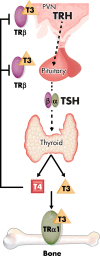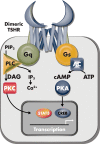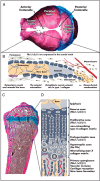Role of Thyroid Hormones in Skeletal Development and Bone Maintenance
- PMID: 26862888
- PMCID: PMC4823381
- DOI: 10.1210/er.2015-1106
Role of Thyroid Hormones in Skeletal Development and Bone Maintenance
Abstract
The skeleton is an exquisitely sensitive and archetypal T3-target tissue that demonstrates the critical role for thyroid hormones during development, linear growth, and adult bone turnover and maintenance. Thyrotoxicosis is an established cause of secondary osteoporosis, and abnormal thyroid hormone signaling has recently been identified as a novel risk factor for osteoarthritis. Skeletal phenotypes in genetically modified mice have faithfully reproduced genetic disorders in humans, revealing the complex physiological relationship between centrally regulated thyroid status and the peripheral actions of thyroid hormones. Studies in mutant mice also established the paradigm that T3 exerts anabolic actions during growth and catabolic effects on adult bone. Thus, the skeleton represents an ideal physiological system in which to characterize thyroid hormone transport, metabolism, and action during development and adulthood and in response to injury. Future analysis of T3 action in individual skeletal cell lineages will provide new insights into cell-specific molecular mechanisms and may ultimately identify novel therapeutic targets for chronic degenerative diseases such as osteoporosis and osteoarthritis. This review provides a comprehensive analysis of the current state of the art.
Figures








References
-
- Medvei VC. A history of endocrinology. Lancaster, UK: MTP Press; 1982.
-
- Braverman LE, Cooper DS. Werner & Ingbar's the Thyroid: a Fundamental and Clinical Text. 10th ed Philadelphia, PA: Lippincott Williams Wilkins; 2013.
-
- Wass JA, Stewart PM. Oxford Textbook of Endocrinology and Diabetes. 2nd ed New York: Oxford University Press; 2011.
-
- Delling G, Kummerfeldt K. Friedrich Daniel von Recklinghausen. A reminiscence on the occasion of the centenary of his publication Osteitis fibrosa or deformans, osteomalacia and osteoplastic carcinosis in their interrelationships [in German]. Dtsch Med Wochenschr. 1991;116:1976–1979. - PubMed
-
- Von Recklinghausen FD. Die Fibrose oder deformierende Ostitis, die Osteomalacie und die osteoplastische Carcinose in ihren gegenseitigen Beziehungen. In: Festschrift Rudolf Virchow zum 13. Berlin: Georg Reimer Verlag; 1891.
Publication types
MeSH terms
Substances
Grants and funding
LinkOut - more resources
Full Text Sources
Other Literature Sources

